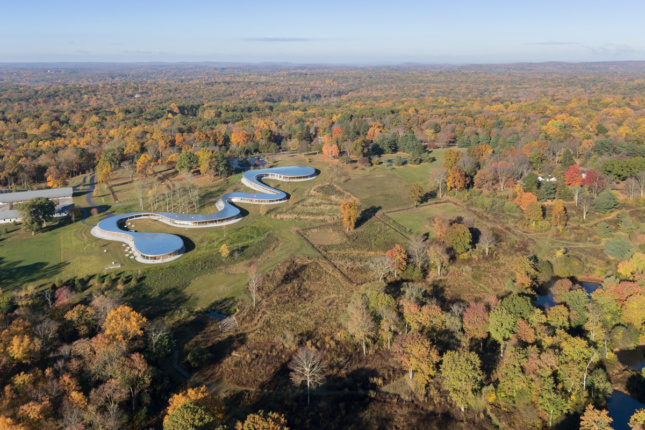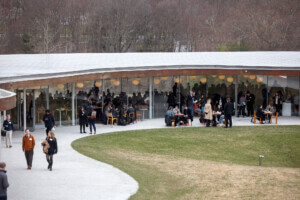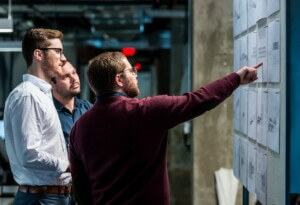This article appears in the September print edition of The Architect’s Newspaper.
The 2018 Global Slavery Index estimated that 24.9 million people around the world are enslaved in forced labor. Although the practice underpins much of the global 21st-century building economy—for example, the index noted that of all imports to the United States that are at risk of being produced under conditions of modern slavery, timber was the fifth largest by value—its invisibility to many in the U.S. has kept the issue from attracting widespread professional attention.
But as consumers become more concerned with where their pants are being made, who grows their coffee beans, and their electricity use, it’s reasonable to expect them to demand that the architecture they inhabit is realized without slave labor, too. The U.S. garment industry—which last year imported $47 billion worth of slave-produced pieces from China, India, Thailand, and Vietnam, among other countries—has been slowly responding to awareness around its corrupt supply chains, and the New Canaan, Connecticut–based Grace Farms Foundation (GFF) wants the building industry to be next.

The design world was recently clued in to the grave issue of labor justice when the late Zaha Hadid said she had “nothing to do” with the hundreds of migrant workers who died on the construction sites of World Cup facilities in Qatar. Many were outraged. Ambassador (ret.) Luis C.deBaca, a senior justice adviser at GFF with expertise in disrupting contemporary slavery and a Robina Fellow at Yale University’s Gilder Lehrman Center for the Study of Slavery, Resistance, and Abolition, said the initial activism that stemmed from controversial megaprojects in the Gulf States shed light on a broader problem in the industry.
“For many in the human rights community, Hadid’s tone-deaf response to the plight of those workers laboring on World Cup projects not only symbolizes the profession’s abdication of responsibility,” C.deBaca said, “but is proof of an ivory-tower nihilism that undercuts architecture’s claim to leadership in designing for community as opposed to wealth.”
C.deBaca is part of an expanding working group of high-profile construction and design professionals, scholars, human rights experts, and industry association leaders gathered by Sharon Prince, GFF president and cofounder, and AN editor-in-chief Bill Menking. To address exploitation in building supply chains, the two brought together many of the principals of the firms that designed and built Grace Farms to educate the industry and develop better practices. They aim to create a LEED-like score sheet to evaluate forced labor’s role in buildings and products, as well as guidelines on how to infuse antislavery language into design briefs, competition rules, contracts, and more.
“It is time to recognize our responsibility,” Prince said, “and subsidizing construction projects with forced labor on job sites is only half of the slavery issue. Illuminating forced labor in building material supply chains, that design teams specify, has not yet begun. We must turn our attention to the built environment and eradicate modern slavery’s permanent imprint.”
To do this, the team is promoting total transparency from the ground up (and even from below the ground; 4 percent of forced labor occurs in the global mining industry, per the International Labour Organization). Brad Guy, former chair of the U.S. Green Building Council’s LEED Materials and Resources Technical Advisory Group, recently joined GFF’s initiative. He’s also a member of the AIA Materials Knowledge Working Group and is developing a pledge that will try to channel interest in the environmental and social impact of building materials. This includes spreading the word on the “dirty dozen”: bricks, copper, electronics, fiber and textiles, glass, granite, gravel, iron, minerals, precursor chemicals, tin, rubber, steel, and stone. He said these often-specified materials are at risk of being sourced unethically on job sites around the world.
“I’m pretty sure that most people would not consciously choose to purchase these building products if they were the product of forced or child labor,” Guy said. “The core of an architect’s standard of care is the health, safety, and welfare of the public, and the point of incorporating human rights as a fundamental criterion in the production of buildings and materials is for that reason.”
According to Nat Oppenheimer, executive vice president of structural engineering firm Silman, highlighting a tight list of materials can help clarify how much easier it has become to track their origins. “It can change the frame for the design community, hopefully motivating others to ask about other materials and start doing their own research, which in turn may spur further innovation on tracking technology and the creation of new clean versions,” Oppenheimer said.
Though the Grace Farms Foundation Architecture + Construction Working Group, as it’s officially called, has been active for only a year, its efforts are moving forward quickly thanks to the diligence of its members and, in part, because there is already substantial awareness out there. “We’re seeing increasing government regulation around the world, whether in specific modern slavery legislation, such as in Australia and the United Kingdom, or in broader business and human rights initiatives coming out of the European Union and the United Nations,” said C.deBaca, who led the State Department’s Office to Monitor and Combat Trafficking in Persons during the Obama Administration. “Anyone doing projects overseas or who has multiple offices, or even who sources materials from outside of the U.S., needs to know about this problem.”
So the team is busy spreading the news. Oppenheimer and C.deBaca will present their work at the International Association for Bridge and Structural Engineering Congress in New York this September, while Deborah Berke, also a member of the working group, is planning a spring series of discussions on the topic at the Yale School of Architecture. Hayes Slade, 2019 president of AIA NY, and Benjamin Prosky, AIA NY executive director, will host a meeting to discuss existing antislavery laws and the more than 45 ethical product and materials certifications or reporting mechanisms that can be applied in the U.S. alone.
“As architects, it’s impossible to look at our work from the products selected to the job site to the completed project and not think about how it all came together,” said Slade. “We are also at a point where information is more readily available and so our expectations and aspirations for transparency are increasing.”
It’s an achievable goal, Prince believes, to get more people on board and boost consciousness of the issue in a short amount of time. She says it will take a serious communication and organization strategy, and that’s why the more experts involved, the better.
“This is an opportunity for industry leaders to use their design and construction wherewithal for significant humanitarian effect through the material procurement and specification process,” Prince said. “And we want to find new projects to test this on. Perhaps Amazon’s new HQ2 in Crystal City, Virginia, is a good place to start since they have distinctly made a commitment to responsible sourcing and developed one of the most sophisticated data platforms that could be tuned to illuminate and audit the building material supply chain. We’re looking for that kind of dedication.”
Sydney Franklin is a member of the GFF Architecture + Construction Working Group, of which AN’s editor-in-chief William Menking is a cofounder. Read more about the group’s efforts to end modern slavery in architecture here.











